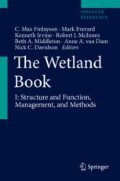Abstract
Sea grasses are characteristic of coastal waters and play an important role in sustaining biodiversity and also facilitate uptake and storage of carbon. These grasses largely occur in shallow waters that are often clear. Hence, mapping can be achieved using optical remote sensing data with the intricacies of sea grass beds best observed at higher spatial resolutions. Hyperspectral data are especially useful as these can be used to better differentiate sea grass species and productivity types and also facilitate better discrimination from other subsurface environments. Acoustic methods (e.g., SONAR) have also been used and provide additional information on the structure of sea grasses and the underlying topography. Remote sensing data can also be used to indicate human-induced disturbance.
References
Dekker AG, Brando VE, Anstee JM. Retrospective seagrass change detection in a shallow coastal tidal Australian lake. Remote Sens Environ. 2005;97(4):415–33.
Dierssen HM, Zimmerman RC, Leathers RA, Downes TV, Davis CO. Ocean color remote sensing of seagrass and bathymetry in the Bahamas Banks by high-resolution airborne imagery. Limnol Oceanogr. 2003;48:444–55.
Ferguson RL, Korfmacher K. Remote sensing and GIS analysis of seagrass meadows in North Carolina, USA. Aquat Bot. 1997;58(3):241–58.
Fyfe SK. Spatial and temporal variation in spectral reflectance: are seagrass species spectrally distinct? Limnol Oceanogr. 2003;48:464–79.
Green EP, Short FT, editors. World atlas of seagrasses. Berkeley: University of California Press; 2003. p. 298.
Green EP, Mumby PJ, Edwards AJ, Clark CD. A review of remote sensing for the assessment and management of tropical coastal resources. Coast Manag. 1996;24(1):1–40.
Gullström M, Lundén B, Bodin M, Kangwe J, Öhman MC, Mtolera MS, Björk M. Assessment of changes in the seagrass-dominated submerged vegetation of tropical Chwaka Bay (Zanzibar) using satellite remote sensing. Estuar Coast Shelf Sci. 2006;67(3):399–408.
Komatsu T, Igarashi C, Tatsukawa K, Sultana S, Matsuoka Y, Harada S. Use of multi-beam sonar to map seagrass beds in Otsuchi Bay on the Sanriku Coast of Japan. Aquat Living Resour. 2003;16(3):223–30.
Lee Z, Carder KL, Mobley CD, Steward RG, Patch JS. Hyperspectral remote sensing for shallow waters. I. A semianalytical model. Appl Optics. 1998;37(27):6329–38.
Mishra DR, Narumalani S, Rundquist D. Enhancing the detection and classification of coral reef and associated benthic habitats: a hyperspectral remote sensing approach. J Geophys Res Oceans. 2007;112(C8).
Montefalcone M, Rovere A, Parravicini V, Albertelli G, Morri C, Bianchi CN. Evaluating change in seagrass meadows: a time-framed comparison of Side Scan Sonar maps. Aquat Bot. 2013;104:204–12.
Mumby PJ, Edwards AJ. Mapping marine environments with IKONOS imagery: enhanced spatial resolution can deliver greater thematic accuracy. Remote Sens Environ. 2002;82(2–3):248–25.
Mumby PJ, Green EP, Edwards AJ, Clark CD. The cost-effectiveness of remote sensing for tropical coastal resources assessment and management. J Environ Manag. 1999;55(3):157–66.
Nellemann C, Corcoran E, editors. Blue carbon. The role of healthy oceans in binding carbon. A rapid response assessment. UNEP/GRID-Arendal: Arendal; 2009.
Phinn S, Roelfsema C, Dekker A, Brando V, Anstee J. Mapping seagrass species, cover and biomass in shallow waters: an assessment of satellite multi-spectral and airborne hyper-spectral imaging systems in Moreton Bay (Australia). Remote Sens Environ. 2008;112:3413–25.
Pu R, Bell S, Baggett L, Meyer C, Zhao Y. Discrimination of seagrass species and cover classes with in situ hyperspectral data. J Coast Res. 2012;28(6):1330–44.
Sagawa T, Mikami A, Komatsu T, Kosaka N, Kosako A, Miyazaki S, Takahashi M. Mapping seagrass beds using IKONOS satellite image and side scan sonar measurements: a Japanese case study. Int J Remote Sens. 2008;29(1):281–91.
Short FT, Coles RG, editors. Global seagrass research methods. Amsterdam: Elsevier Science; 2001. p. 473.
Author information
Authors and Affiliations
Corresponding author
Editor information
Editors and Affiliations
Rights and permissions
Copyright information
© 2018 Springer Science+Business Media B.V., part of Springer Nature
About this entry
Cite this entry
Lyons, M., Lucas, R. (2018). Remote Sensing of Wetland Types: Sea Grasses. In: Finlayson, C.M., et al. The Wetland Book. Springer, Dordrecht. https://doi.org/10.1007/978-90-481-9659-3_313
Download citation
DOI: https://doi.org/10.1007/978-90-481-9659-3_313
Published:
Publisher Name: Springer, Dordrecht
Print ISBN: 978-90-481-3493-9
Online ISBN: 978-90-481-9659-3
eBook Packages: Biomedical and Life SciencesReference Module Biomedical and Life Sciences

